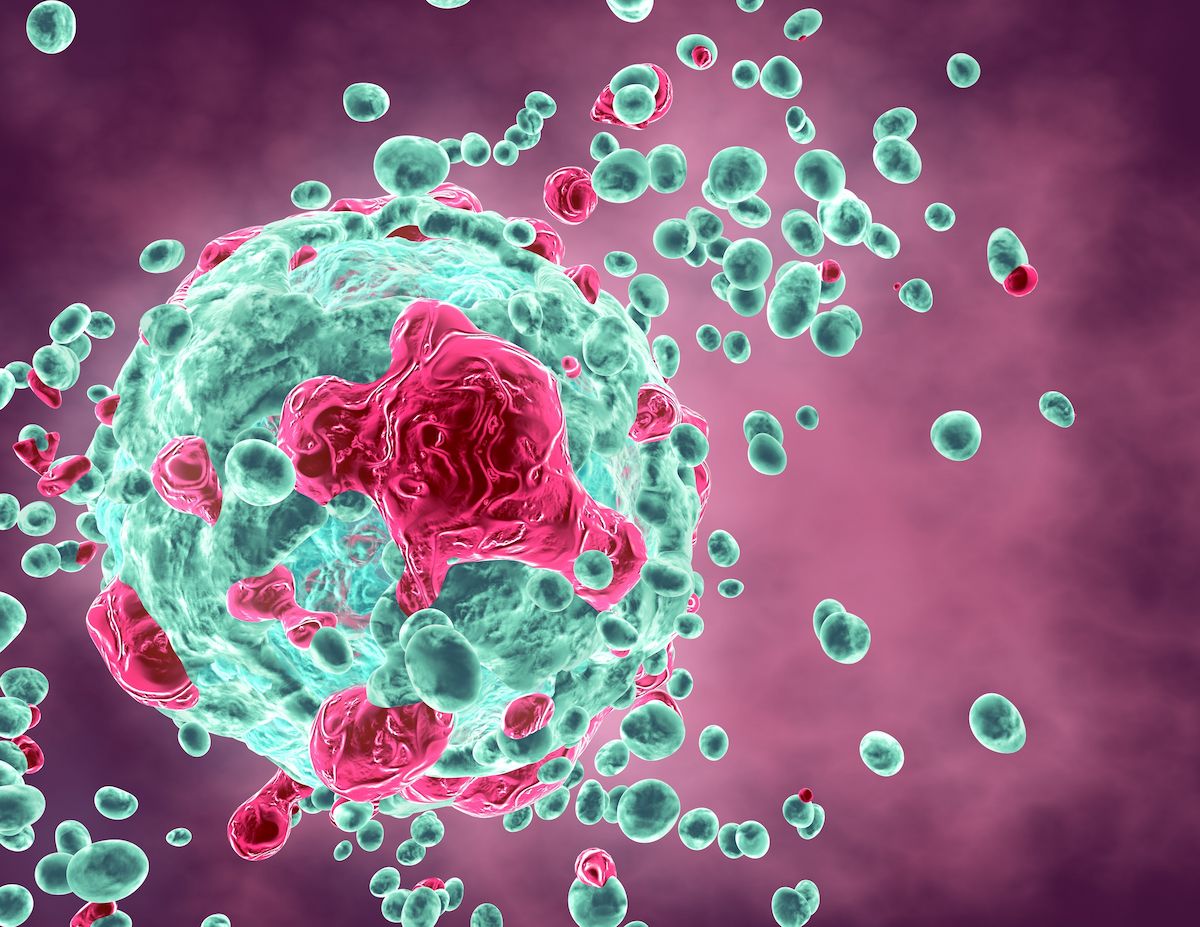Adjuvant Chemotherapy Improves Long-Term Survival in Endometrial Cancer
The most pronounced overall and recurrence-free survival benefit with chemoradiotherapy was observed among patients with TP53-abnormal endometrial cancer.
At a median follow-up of 10.1 years, among 330 patients treated with chemoradiotherapy vs 330 patients treated with radiotherapy alone, 84 and 105 had died, respectively; a total of 65 (77%) and 85 (81%) deaths were related to endometrial cancer.

The addition of adjuvant chemotherapy to radiotherapy exhibited an improvement in 10-year overall survival (OS) and recurrence-free survival (RFS) vs radiotherapy alone among patients with high-risk endometrial cancer, according to long-term findings and a post hoc analysis of the phase 3 PORTEC-3 trial (NCT00411138) published in The Lancet Oncology.
At a median follow-up of 10.1 years (IQR, 9.8-11.0), among 330 patients treated with chemoradiotherapy vs 330 patients treated with radiotherapy alone, 84 and 105 had died, respectively; a total of 65 (77%) and 85 (81%) deaths were related to endometrial cancer. Additionally, secondary malignancies accounted for 8 (10%) and 11 (10%) deaths in the respective arms. The estimated 10-year OS in each arm was 74.4% (95% CI, 69.8%-79.4%) and 67.3% (95% CI, 62.3%-72.7%; adjusted HR, 0.73; 95% CI, 0.54-0.97; P = .032).
Furthermore, 91 patients in the chemoradiotherapy group and 107 in the radiotherapy group experienced disease recurrence. The estimated 10-year RFS rate in each respective arm was 72.8% (95% CI, 67.2%-77.6%) and 67.4% (95% CI, 61.7%-72.4%; adjusted HR, 0.74; 95% CI, 0.56-0.98; P = .034). The median OS following recurrence was 1.4 years (IQR, 0.4-4.3) across both treatment groups as well as 1.2 years (IQR, 0.4-8.8) vs 1.4 years (IQR, 0.7-3.9) in the chemoradiotherapy vs radiotherapy groups, respectively (P = .90).
By molecular subgroup, the 10-year OS rates for chemoradiotherapy vs radiotherapy alone was 52.7% (95% CI, 40.8%-68.1%) vs 36.6% (95% CI, 25.0%-53.7%) in patients with TP53-abnormal endometrial cancer (adjusted HR, 0.52; 95% CI, 0.30-0.91; P = .021); 100.0% (95% CI, 100.0%-100.0%) vs 96.4% (95% CI, 89.8%-100.0%) for POLE-mutated cancers (log-rank P = .40); 68.7% (95% CI, 58.1%-81.2%) vs 74.4% (95% CI, 64.4%-86.0%) for mismatch repair–deficient (MMRd) cancers (adjusted HR, 1.34; 95% CI, 0.71-2.55; P = .37); and 81.2% (95% CI, 72.1%-91.4%) vs 74.1% (95% CI, 63.2%-86.8%) for cancers with no specific molecular profile (NSMP; adjusted HR, 0.60; 95% CI, 0.27-1.32; P = .21).
Moreover, the 10-year RFS rate by molecular subgroups in the respective arms was 52.6% (95% CI, 38.3%-65.0%) vs 37.0% (95% CI, 23.7%-50.2%) for TP53-abnormal cancers (adjusted HR, 0.42; 95% CI, 0.24-0.74; P = .0027); 100.0% (95% CI, 100.0%-100.0%) vs 96.4% (95% CI, 77.2%-99.5%) for POLE-mutated cancers (log-rank P = .40); 72.9% (95% CI, 59.1%-82.7%) vs 76.4% (95% CI, 63.4%-85.3%) for MMRd cancers (adjusted HR, 1.13; 95% CI, 0.59-2.15; P = .72); and 72.8% (95% CI, 59.0%-82.6%) vs 61.7% (95% CI, 47.0%-73.4%) for NSMP cancers (adjusted HR, 0.61; 95% CI, 0.33-1.15; P = .13).
“This long-term analysis of the PORTEC-3 trial with 10-year outcomes supports previous findings of a significant improvement in both [OS and RFS] with chemoradiotherapy compared with radiotherapy alone for patients with high-risk endometrial cancer. Most recurrences occurred at distant sites, with excellent local and regional nodal control in both treatment groups,” Cathalijne C.B. Post, MD, of the Department of Radiation Oncology at Leiden University Medical Center in the Netherlands, wrote in the publication with study coinvestigators. “This long-term analysis shows improved 10-year OS and RFS for patients with high-risk endometrial cancer treated with chemoradiotherapy vs radiotherapy alone, with most clinically relevant benefit from chemoradiotherapy suggested for [TP53-abnormal] cancers.”
The open-label, multicenter phase 3 trial was led by the Dutch Gynaecological Oncology Group and enrolled adult patients with high-risk endometrial cancer, defined as endometrioid-type disease; International Federation of Gynecology and Obstetrics (FIGO) 2009 stage I; grade 3 with deep myometrial invasion or lymphovascular space invasion; stage II, IIIA, IIIC, or IIIB endometrioid cancer; or stage I, II, or III disease with serous or clear cell histology. Patients were randomly assigned 1:1 to receive adjuvant chemoradiation or radiation alone, stratified by group, surgery type, FIGO stage, and histology type.
Those treated in the radiotherapy group received pelvic radiotherapy at 48.6 Gy in 1.8-Gy fractions 5 times weekly and a brachytherapy boost in the event of cervical stromal involvement. Patients in the chemoradiotherapy arm received the same radiotherapy dose plus 2 concurrent cycles of 50 mg/m2 intravenous cisplatin during weeks 1 and 4 of radiotherapy followed by 4 adjuvant cycles of carboplatin at area under the curve 5 and intravenous paclitaxel at 175 mg/m2 at 3-week intervals.
In the chemotherapy and radiation alone arms, the median age was 62.4 years (IQR, 56.5-67.9) and 62.0 years (IQR, 55.8-68.2), respectively, with 18% vs 19% of patients being 70 years or older. Patients mostly had stage II (24% vs 27%) or III (46% vs 43%) disease and endometrioid grade 1 to 2 (39% vs 40%) or 3 (32% each) disease, and 40% vs 58% had lymphovascular space invasion. The most common type of surgery received was total abdominal hysterectomy with bilateral salpingo-oophorectomy plus lymph node dissection or full staging (43% vs 40%), and the most common molecular classes were MMRd (32% vs 36%), NSMP (32% vs 27%), and TP53 abnormal (25% vs 23%).
The primary end points of the analysis were 10-year OS and RFS. Long-term patterns of vaginal, pelvic, and distant recurrences as well as safety were among the secondary end points.
Reference
Post CC, de Boer SM, Powell ME, et al. Adjuvant chemoradiotherapy versus radiotherapy alone in women with high-risk endometrial cancer (PORTEC-3): ten-year clinical outcomes and post-hoc analysis by molecular classification from a randomised phase 3 trial. Lancet Oncol. 2025;26:1370-1381. doi:10.1016/S1470-2045(25)00379-1
Late Hepatic Recurrence From Granulosa Cell Tumor: A Case Report
Granulosa cell tumors exhibit late recurrence and rare hepatic metastasis, emphasizing the need for lifelong surveillance in affected patients.